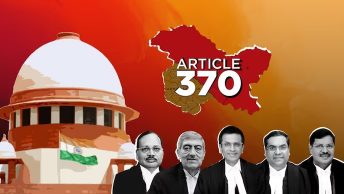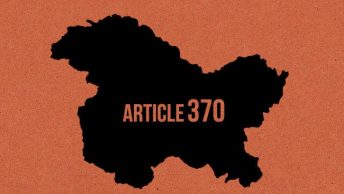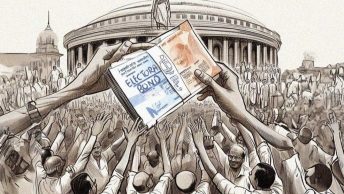With the aim of enabling our readers to keep up with the Supreme Court of India’s day-to-day hearings for the significant case concerning the abrogation of Article 370, LAOT, in collaboration with the Centre for Constitutional Law, NALSAR is bringing you a concise daily summary of what was argued in the Court. This is the summary of Day-2 proceedings, and follows in the argumentative continuum surrounding the debated impermanence of Article 370, covering, among other things, thoughts from the perspective of the reactions and activism of the main legislative body, the Constituent Assembly, at the time.
Note: The arguments today proceeded on the finer points of interpreting Article 370 of the Indian Constitution, mainly around the role played by marginal notes, the willfulness of the Constituent Assembly’s engagement with the 1954 Constitutional Order, and thoughts on the debated impermanence of the Article in question.
The Meaning of ‘Concurrence,’ ‘Consultation,’ and the Significance of the Constitutional Orders
When the bench assembled today morning, Senior Advocate Mr. Kapil Sibal, representing Mohammad Akbar Lone (petitioner and MP from North Kashmir, and a leader of the National Conference party) spoke about the complexities concerning the interpretation of Article 370.
Mr. Sibal said that the substantive provisions of the Constitution of India, including the Fundamental Rights, Directive Principles of the State Policy, Article 356 became applicable to Jammu and Kashmir through The Constitution (Application to Jammu and Kashmir) Order, 1954. The application of these provisions was carried out through the application order or ‘Basic Order.’ It has to be noted that these powers of the President conferred by clause (1) of Article 370 were made applicable with the “concurrence” of the Government of the State of Jammu and Kashmir. (emphasis supplied)
The text of Article 370 is presented here for ease of access:
- Temporary provisions with respect to the State of Jammu and Kashmir
(1) Notwithstanding anything contained in this Constitution,—
(a) the provisions of article 238 shall not apply now in relation to the state of Jammu and Kashmir;[d]
(b) the power of Parliament to make laws for the said state shall be limited to—
(i) those matters in the Union List and the Concurrent List which, in consultation with the Government of the State, are declared by the President to correspond to matters specified in the Instrument of Accession governing the accession of the State to the Dominion of India as the matters with respect to which the Dominion Legislature may make laws for that State; and
(ii) such other matters in the said Lists as, with the concurrence of the Government of the State, the President may by order specify.
Mr. Sibal noted that the lists mentioned under Article 370(1)(b)(i) and (ii) talk of the lists on which the “dominion legislature” may make laws. If the Union law is passed in relation to J&K and relates to the Instrument of Accession (“IoA”), the “consultation” of the Government of the State has to be sought. However, if it concerns the Basic Order, it is “concurrence” that needs to be sought. Mr. Sibal reminded the five-judge bench that the application of the substantive parts of the Constitution was carried out between 1951-1957 when the Constitution of J&K was being made. Since the Basic Order of 1954 had already replaced The Constitution (Application to Jammu and Kashmir) Order, 1950, nothing was done by the Union Government without the concurrence except for the items mentioned in Article 370 on which the Union of India had direct lawmaking powers. It should be noted that the 1950 Order, which was also the President of India’s First Order under Article 370, contained the expression “consultation” with the Government of J&K. Mr. Sibal then noted that the solemn promise that was made between the two entities meant that there would not be a change of boundaries. Dividing the State into two union territories was done without concurrence.
CJI Chandrachud then asked if there was a distinction between ‘consultation’ with the Government of the State as referred to in the first proviso to Article 370(1)(d) and clause (b) (i). Mr. Sibal then said that Clause (b) (i) deals with the Lists and is about making laws. CJI then opined that 370(1)(b) referred to the specification of matters covered by IoA, in respect of which the Union could make laws. He also said that the first proviso to (d) would not cover that category. Chief Justice Chandrachud observed that the meaning that could be attributed to the proviso to Article 370(1)(d) is that in case of creating an exception or making a modification to another provision of the Constitution, the President has the power to do that. He also observed that if the President created such a modification or exception, a “consultation or concurrence” in terms of the second proviso would be required. The Chief Justice queried if there was a concurrence or consultation requirement when the President made no modification or exception.
Mr. Sibal referred the Chief Justice to 370(1)(b) and said that the provision did not say anything apart from specifying lists under which the Union government could make laws. CJI then rightly observed that clause (d) was a limiting clause. It put a limitation on the Parliament to make laws rather than conferring any power to enact laws. He asked whether the power of the Parliament to enact laws was traceable elsewhere. Mr. Sibal then argued that the clause gave the Parliament the power to make law with respect to the lists in IoA- but in consultation. (Emphasis mine)
Justice Kaul observed that it was a double limitation. Mr. Sibal argues that it contains the contours under which the parliament will enact the law. He then distinguishes it from (d). Article 370(1)(d) talks about the Preamble, Article 356, fundamental rights, and other provisions of the Constitution of India that require the concurrence of the State. In the present context, this would mean the erstwhile State of Jammu and Kashmir before its reorganization in 2019. Mr. Sibal then makes the difference more apparent. He says that under 370(1)(b), no orders are issued, while in clause (d), the word “issued” is clearly mentioned. CJI then notes the possible constructions of clause (d). If the President makes exceptions or modifications, it relates to (b)(i), for which consultation is required. And if it refers to something other than a (b)(i) subject, concurrence of the State is required. Thus, consultation or concurrence is required when modifications or exceptions are created. CJI then observes that another possibility is that if a provision of the Constitution applicable to the State of J&K is being made, even without exception or modification, consultation or concurrence is still required.
On Headings and Marginal Notes
A volley of counterarguments ensued. Mr. Sibal argued that Article 370 is beyond alterable. Justice Khanna, however, observed that (c) makes it clear that Article 370 can be touched. Mr. Sibal retorted by saying that it is a marginal note, not the heading of the provision, then reminding the judges of Keshavananda Bharati and its observation to not look at marginal notes. CJI pointed out that Keshavananda says it in the sense that the marginal does not control the meaning of the text. Mr. Sibal said neither Article 370(1)(c) nor Article 3 can imply that the provision is temporary. According to Mr. Sibal, a marginal note cannot lay down such a position.
The Parliament and the First Order
Mr. Sibal then drew the judges’ attention to The Constitution (Application to Jammu and Kashmir) Order, 1950. He referred them to the index of the Order and says that fifty-four such orders have been passed over time. He read from the Index: “In addition to the provisions of Art 1 and 370, the only other provisions of the Constitution which shall apply shall be those specified in the second schedule…” He then argued that this proposition becomes applicable to (d). He reminded the judges that it was after the significant parts of the Constitution came to apply to the state- but all with the concurrence of the State. Sibal then referred to the Constitution Order of 1954. Justice Khanna opines that the exception was that the entire Constitution was adopted, subject to modifications. Justice Khanna asked if Article 356 was excluded from this. 356 was excluded from what the 1954 Order made applicable.
The Permanence of Article 370
Justice Kaul opined that it is debatable whether Article 370 has acquired a permanent feature, but if it is supposed that it has not, is the procedure followed in the case? Mr. Sibal then directed the judges to the Constitution of J&K. Mr. Sibal reminds them of the 1954 Order, which was made when the Constituent Assembly was still functioning. The Constituent Assembly could have made a choice, but they crucially chose not to.
Justice Kaul again asks if Article 370 acquired a permanent character and whether a methodology exists to abrogate it.
Senior Advocate Gopal S articulated an interesting dissection of the provision. He said that Article 370 has three parts. The first part always continues. The second part deals with what happens before the Constituent Assembly comes in and therefore is transitory. The third part is temporary, which is when Constituent Assembly was functioning.
Towards lunch, CJI Chandrachud put forward an intriguing query. He asked whether the permanency of Article 370 can be a consequence that follows from the Constitution of J&K. Mr. Sibal did not seem to agree and says that 370 was made applicable by an application order. Justice Kaul asked the same question about J&K Constitution giving permanency to Article 370. Mr. Sibal said that the Legislative Assembly does not have the power under 370(3). The legislature cannot amend 370(3), which is what the government did.
What Constitutes the Government of the State
CJI Chandrachud referred to the Explanation to (b), which defines the ‘Government of the State’ and does not include the Maharaja. It means “the person for the time being recognized by the President as the Maharaja.” CJI asked about the possibility when an elected government replaces the Maharaja. Sibal then said the elected government, on the aid and advice of the council of ministers, will say that. Mr. Sibal saif such an understanding is reflected in the understanding of the Constitution of J&K after being asked by the CJI where it was contained. Mr. Sibal said Sadar-i-Riyasat was to be in the government according to the Government Order of 1965.
The Governor’s Powers
Sibal referred to the J&K Constitution. He argues that the Governor may dissolve the assembly only with the aid and advice of the Council of Ministers (CoM). Then he saif that there was no council of ministers when the governor dissolved the assembly. He quoted from the Constitution of J&K and laid down the exceptions when the governor can act without the aid and advice of the CoM. He established that the Governor’s action is not covered under the exceptions.
Is the J&K Constitution Subordinate to the Indian Constitution
CJI referred to Article 147 of the J&K Constitution and opined that the provisions of the J&K Constitution are to be treated as subordinate to the Indian Constitution. The Chief Justice says it (J&K Constitution) is a subordinate instrument. Mr. Sibal does not dispute this assertion and says that from the perspective of the Constituent Assembly, the relationship was permanent. He argued that the provisions of the Constitution of Jammu and Kashmir make it clear that they exercised their choice. Mr. Sibal then asked that if it is happening under Article 356, the procedure needs to be seen. Mr. Sibal again referred to Keshavananda Bharati. He laid out the distinction between the exercise of constituent power and legislative power. Parliament functions within the contours of the Constitution, while a Constituent Assembly has no constitution. Mr. Sibal said that converting the legislative assembly into a constituent assembly was like clapping by one hand, a procedure unknown to law.
CJI Chandrachud then queried that if the legislative assembly had not dissolved, they could have exercised the power of the constituent assembly. Since it dissolved, the Parliament took it upon itself to exercise that power.
The Bench rises for lunch.
In our next post, we will cover the post-lunch journey of today’s proceedings.
Aurif Muzafar is a doctoral fellow at NALSAR. He is also a Research Associate for the MK Nambyar SAARC Law Center, NALSAR.
[Ed Note: This piece is part of our series covering the hearing on the abrogation of Article 370. This post has been edited by Utkarsh Mani Tripathi and posted by Harshitha Adari from our Student Editorial Team]






